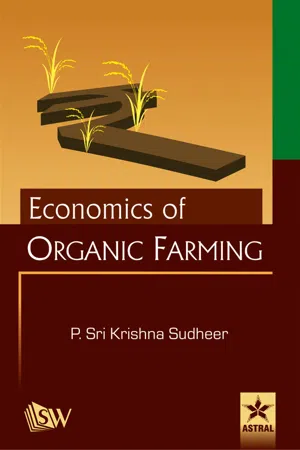eBook - PDF
Economics of Organic Farming
About this book
This book has brought comparative analysis of the Organic Farming practices vis-à-vis Conventional Farming practices of Paddy, Redgram, Ground Nut in three regions i.e Coastal Andhra, Telangana and Rayalaseema of Andhra Pradesh. This book brings out the fact as how Organic Farming practices is much more beneficial than Conventional Farming practices. In addition, this book covers Technical Efficiency, Allocative Efficiency and Economic Efficiency of crops estimated under Frontier Production Function Analysis and Data Envelopment Analysis. This book will be an addition to the existing body of literature in Indian Agriculture in general and Organic Agriculture in particular.
Frequently asked questions
Yes, you can cancel anytime from the Subscription tab in your account settings on the Perlego website. Your subscription will stay active until the end of your current billing period. Learn how to cancel your subscription.
At the moment all of our mobile-responsive ePub books are available to download via the app. Most of our PDFs are also available to download and we're working on making the final remaining ones downloadable now. Learn more here.
Perlego offers two plans: Essential and Complete
- Essential is ideal for learners and professionals who enjoy exploring a wide range of subjects. Access the Essential Library with 800,000+ trusted titles and best-sellers across business, personal growth, and the humanities. Includes unlimited reading time and Standard Read Aloud voice.
- Complete: Perfect for advanced learners and researchers needing full, unrestricted access. Unlock 1.4M+ books across hundreds of subjects, including academic and specialized titles. The Complete Plan also includes advanced features like Premium Read Aloud and Research Assistant.
We are an online textbook subscription service, where you can get access to an entire online library for less than the price of a single book per month. With over 1 million books across 1000+ topics, we’ve got you covered! Learn more here.
Look out for the read-aloud symbol on your next book to see if you can listen to it. The read-aloud tool reads text aloud for you, highlighting the text as it is being read. You can pause it, speed it up and slow it down. Learn more here.
Yes! You can use the Perlego app on both iOS or Android devices to read anytime, anywhere — even offline. Perfect for commutes or when you’re on the go.
Please note we cannot support devices running on iOS 13 and Android 7 or earlier. Learn more about using the app.
Please note we cannot support devices running on iOS 13 and Android 7 or earlier. Learn more about using the app.
Yes, you can access Economics of Organic Farming by Sudheer, P Sri Krishna in PDF and/or ePUB format, as well as other popular books in Technology & Engineering & Agriculture. We have over one million books available in our catalogue for you to explore.
Information
Table of contents
- Acknowledgements
- List of Tables
- Abbreviations
- 1. Introduction
- 1.1 Definition of Organic Farming
- 1.2 Historical Background of Organic Farming
- 1.3 Status of Organic Farming In The World
- 1.4 Status of Organic Farming In India
- 1.5 The Problem
- 1.5 Need for the Study
- 1.7 Objectives
- 1.8 Methodology and Sample Design
- 1.9 Techniques Used
- 1.10 Concepts Used In The Study
- 1.11 Different Concepts of Cost Of Cultivation
- 1.12 Concepts of Income
- 1.13 Chapterisation
- 2. Review of Literature
- 3. Brief Profile of the Study Area: Topography of the Select Districts
- 3.1 Demographic Particulars
- 3.2 Literacy Levels
- 3.3 Occupational Pattern
- 3.4 Rainfall
- 3.5 Irrigation
- 3.6 Livestock And Poultry Population
- 3.7 Land Utilisation Pattern
- 3.8 Area Under Principal Crops
- 3.9 Cropping Pattern
- 3.10 Land Holding Particulars
- 4. Profile of the Sample Households
- 5. Costs of Cultivation and Returns From Organic vis-a-vis Conventional Farming
- 5.1 Cost of Cultivation
- 5.2 Resource Use Pattern
- 5.3 Different Types of Costs
- 5.3.1 Prime Cost
- 5.3.2 Operational Cost
- 5.3.3 Overhead Costs
- 5.3.4 Paid-out Cost
- 5.3.5 Imputed Cost
- 5.4 Returns From Farming
- 5.4.1 Gross Income
- 5.4.2 Farm Business Income
- 5.4.3 Family Labour Income
- 5.4.4 Farm Investment Income
- 5.4.5 Net Income
- 6. Economic Efficiency of Organic Farming vis-a-vis Conventional Farming
- 6.1 The Stochastic Frontier and Efficiency Model
- 6.2.1 Efficiency of Paddy Cultivation under CRS, VRS and SE
- 6.2.2 Efficiency of Redgram Cultivation under CRS, VRS and SE
- 6.2.3 Efficiency of Groundnut Cultivation under CRS, VRS and SE
- 6.2.4 Efficiency of Paddy Cultivation (TE, AE and EE) under CRS
- 6.2.5 Efficiency of Redgram Cultivation (TE, AE AND EE) under CRS
- 6.2.6 Efficiency of Groundnut Cultivation (TE, AE and EE) under CRS
- 6.2.7 Efficiency of Paddy Cultivation (TE, AE AND EE) under VRS
- 6.2.8 Efficiency of Redgram Cultivation (TE, AE and EE) under VRS
- 6.2.9 Efficiency of Groundnut Cultivation (TE, AE and EE) under VRS:
- 6.3.1 Method of Estimation
- 6.3.2 Variables Used
- 6.3.3 Results
- 7. Summary, Conclusions and Policy Implications
- • The Problem
- • Need for the Study
- • Objectives
- • Methodology an d Sample Design
- • Techniques Used
- • The Stochastic Frontier and Efficiency Model
- • The Dea Model:
- • Factors Determining Technical Efficiency Model
- • Limitations of the Study
- • Issues For Further Research
- • Major Findings
- • Policy Implications
- Select Bibilography
